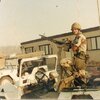i had a neighbor long passed who served as an MP and medic in ww2. I believe his wife had been a secretary involved in the Manhattan project.
I am just wondering what weapons he would have carried in his positions in ww2.
As a medic, i don't think he would have been armed in ww2?
As an Mp I think it could have been any number of weapons, The 1911 comes to mind first and foremost, or maybe a winchester shotgun for guarding prisoners and possibly the M1 Garand and possibly m1 carbine.
I do seem to remember him mentioning the Garand.
Thanks
Remembering those who fell so freedom could stand.
I am just wondering what weapons he would have carried in his positions in ww2.
As a medic, i don't think he would have been armed in ww2?
As an Mp I think it could have been any number of weapons, The 1911 comes to mind first and foremost, or maybe a winchester shotgun for guarding prisoners and possibly the M1 Garand and possibly m1 carbine.
I do seem to remember him mentioning the Garand.
Thanks
Remembering those who fell so freedom could stand.



